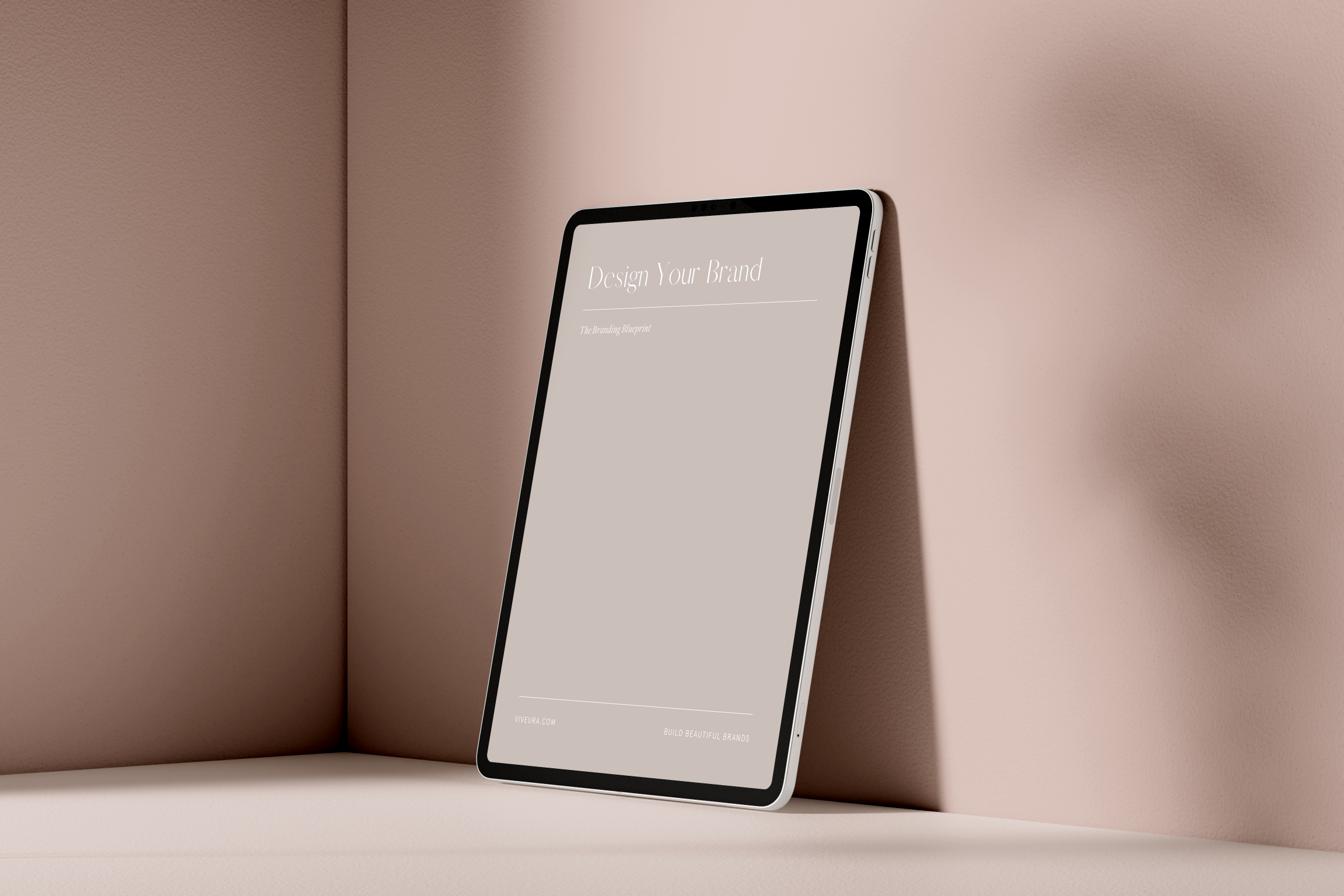Create a Beautiful Brand With This 4-Step Brand Strategy
Want to build a unique brand that attracts and delights customers, and catapults your business to new levels of growth and revenue? Read on for our brand strategy basics.
Our ability to build brands has led to professional success and, through our brand atelier, we have advised hundreds of entrepreneurs, creatives, and executives on how to build their brand presence in order to attract and nurture customers and grow revenue as a result.
From this experience, we’ve come to realize that there is no consensus when it comes to what branding is, why it’s important, and how to do it right. Some perceive branding as a nice-to-have exercise but not really something you need to devote much time or energy to in the grand scheme of things. Others deem it as important but place it squarely in the “design” category and completely disregard the need for strategy.
There are many misunderstandings and misconceptions that prevail. This is why we created a step-by-step blueprint for how to build an elevated brand. We want to dispel the myths and give you a simple playbook so you don’t downplay or mismanage a process that can catapult your business to new levels.
How to Build a Brand
Brand Your Business Mindfully
Dispel These 5 Myths
Prepare for the Process
A Brand Strategy Framework
Brand Your Business Mindfully
Before you start diving into the branding blueprint, make sure you go into it with the right mindset. You may be familiar with the slow movement with its “do it well instead of fast” philosophy that has permeated dozens of industries from food and fashion to education and travel.
In the midst of the frenzy of trying to grow your business, it’s easy to forget the value of cultivating a loving and loyal community. From "MVP” to “growth hacking” to “going viral", the tools and terminology you may be using to build your business are all about scaling quick. As a result, you may be tempted to release half-baked, low-quality products and services into a market that is probably already oversaturated with subpar offerings.
We’re not advocating moving your business at a glacial pace — just at a more thoughtful and reasonable speed. Commit now to trading in vanity metrics and get rich quick schemes in the short-term in order to build a brand that you and your consumers and clients will fall in love with over the long-term.
Instead of random tactics and transactions, understand the important of creating a solid brand strategy and enjoy the process of creating and crafting vs. just fixating on end goals. Isn’t this why you are in this line of business in the first place? This mindset shift is especially important if you are launching a luxury brand.
Don’t be afraid to take the time to think, get theoretical, and have intellectually-stimulating discussions about your brand. You can use our slow branding principles to start: priority, quality, loyalty. Set your priority and spend enough time on it so that it results in a high quality outcome that has the best chance of garnering loyalty. Your brand is nothing more than a promise: a promise to be who you say you will be to the audience you claim you serve.
Our most critical advice is to stay true to your promise. Being an entrepreneur or executive is hard work and nothing guarantees your success. However, being mindful about what you are delivering, and going about your branding activities in a deliberate way, puts you in the best position to benefit from those serendipitous moments that may take your brand from nothing to something.
Dispel These 5 Branding Myths
Now that you are in the right mindset, we want to take a moment and dispel the myths about branding (or re-branding) so you don’t go into the process with biases.
Myth 1: You know exactly what branding involves
Odds are you don’t. Most of our clients come to us with strong opinions about what they believe they need to do to build or refresh their brand. It only takes a 15-minute conversation before they realize they are overly fixated on a small part of a much bigger picture.
Branding is not just revamping creative. This is merely a tactical element that, in the absence of a thoughtful strategy, won’t help you package and present the business to potential customers in an effective way. Branding is a rigorous data-driven process of discovering unmet customer needs and mapping them to your company’s capabilities.
Myth 2: You don’t really need to brand a business
If you care about your business strategy and reputation then you do. We live in a time where information — be it fake, real, true or false, is easily accessible to all — via the internet. That means that your reputation is built almost entirely on what is accessible online.
Unflattering information — or even worse, irrelevant or complete lack of information — can work against you, especially if you are trying to position yourself or establish your business in a competitive field. You may have a personal aversion to this but it doesn’t matter because it’s the reality of the world we live in. You have to, at minimum, create a legitimate digital presence that resonates to build credibility with your audience.
Myth 3: You can easily brand your business
You can, but it’ll probably be easier if you sought professional help unless your company has built up the relevant strategic and creative capabilities in-house. The main reason for seeking help, if your company aren’t already savvy brand builders, is that you need a proven process to follow.
If you have no experience in branding then you probably have no clue where to start. Without guidance you will likely make the aforementioned mistake of working on random tactics that don’t really add value to your bottom line.
Myth 4: You have to invest a fortune into branding
Not true at all. However, we know where this myth comes from. We’ve worked for and advised a range of brands — from iconic Fortune 500s to fast growing startups — that have allocated millions of dollars to agencies and consultancies (we’ve even approved multi-million dollar agency budgets ourselves).
At times we’ve been appalled at what that investment ultimately resulted in. Often the outcomes were not worth what was spent. So we see why there is a general perception that branding is ridiculously expensive.
Yes, some companies are spending fortunes on subpar work, but that doesn’t need to be you. Quality doesn’t come free so you’ll need to make a reasonable investment, but it need not be outrageous. Whatever resources you have at your disposal use them wisely, but don’t be afraid to invest in your brand.
Myth 5: A brand can maintain itself forever
Your brand is a significant component of your overall business strategy. In doing so you’ll come to appreciate the journey instead of being fixated on a final destination. Just as you are always evolving as a person so is your business, and it will likely go through many phases and changes that alter your vision. As this vision evolves you may need to make adjustments to your brand strategy so it stays in sync.
Your brand is dynamic not a one-time build that stays static. It should be firm enough that it helps you clearly communicate who you are and what you stand for. But it should also be fluid enough to adapt to inevitable changes in market, competitor and consumer dynamics.
Prepare for the Branding Process
So now that we’ve alleviated the myths, let’s explore the pre-work needed prior to jumping into a branding or re-branding initiative. You need to be efficient with your time and resources and ensure that you end up with an outcome that resonates with your intended audience.
Ultimately, you want the end product to set you apart from other businesses in your category, and to influence consumers to gladly choose you over the plethora of other options. To get to that point you need to go into the branding process empowered with the right tools and the correct frame of mind. Here are 5 questions that will help you do that.
Question 1: What is your definition of a brand?
Some say it's a "unique design, sign, or symbol" while others state it's a "product, service, or concept." Still some go further and define it as "a promise" to consumers. How do you define it? Whatever your definition it needs to be well-informed so there is no confusion and you don't skip important steps, during the branding process.
Question 2: Why is branding necessary for your business?
You need to have a clear view into how branding (or rebranding) fits into your long-term business plan and marketing strategy, and should be able to justify the exercise with both quantitative and qualitative impact.
Question 3: What investments are you willing to make?
You have to be real with yourself about the tools that you have at your disposal and adopt a resourceful mindset so you can maximize their use. There are three main resource categories to evaluate - money, talent, and time.
Question 4: What is your brand vision?
Without a vision your brand strategy and visual identity will feel off to you and your target audience. Take the time to get granular about what you want out of your business then determine how this translates to your mission, values, and goals.
The Brand Strategy Framework
Now it’s time to get into the actual detail of what a brand strategy entails. In The Branding Blueprint, we dive deep into what we call the four 4Vs framework: Vision, Value, Voice, Visuals.
Vision
It’s important to go through the exercise of articulating the strategic vision for yourself or your company before get into other parts of the branding process. Your vision must inform your entire strategy.
Value
Your value is what you have to offer that is unique, important, and relevant in the eyes of the consumer. It should specifically address the most pressing consumer needs, problems, or desires and it gets at the heart of why you or your business should be chosen over others.
Voice
You should be purposeful in your manner of communication by focusing on what you say, how you say it, and the feeling it conveys. It's important to carefully craft a distinct prose that engages, inspires, motivates, influences, and establishes trust.
Visuals
The visible elements of your brand impart a symbolic meaning that goes beyond what words alone can express. Your visual identity sets the foundation necessary for your brand to be distinguishable, recognizable, and relatable.
You can build a best-in-class brand from scratch, without spending a fortune, if you understand the blueprint. By being efficient you'll end up branding your business in a way that resonates with your intended audience, distinguishes you from your peers, and drives business revenue.























